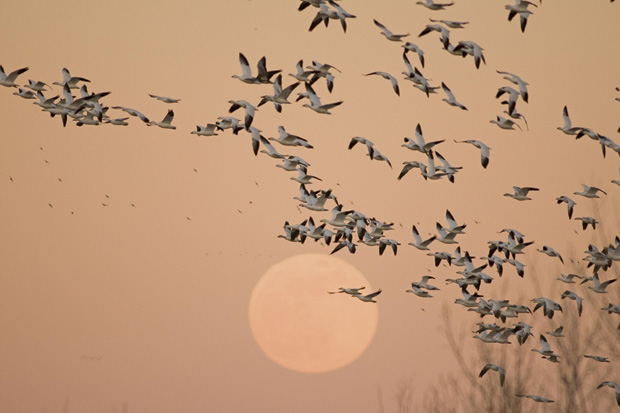Consider for a moment the plight of the willow warbler. Russian birds of this species fly between eastern Siberia and southern Africa and back every year of their short lives, a distance of nearly 7,500 miles in each direction. Each weighs roughly as little as two teaspoons-full of sugar.
But at least these tiny birds can refuel on their journey. Southern bar-tailed godwits are unluckier. These fly the 7,000 or so miles between New Zealand and Alaska over the immense Pacific Ocean — hence non-stop — twice each year. Moreover, Arctic terns migrate from the Antarctic to the Arctic and back again: a fledgling of this species, born on the Farne islands off the Northumberland coast, was recorded only three months later near Melbourne, Australia. And some shear-water have been tracked flying up to 46,000 miles per year, so that a 30-year-old bird could have flown the equivalent of 50 circuits around planet Earth.
Small wonder, perhaps, that the novelist-cum-moral philosopher Dame Iris Murdoch declared such migratory arrangements in a 1982 lecture (with comical seriousness) ‘wasteful and immoral’ and, moreover, ‘convincing evidence of the non-existence of God’. It is thought that 2 billion passerines, 2.5 million wildfowl, 2 million raptors and millions of waders migrate from Eurasia all around the Arctic to winter in Africa.
Hunger and exhaustion are not the only perils such birds face. I once saw black-necked cranes sailing over the Himalayas at great altitudes from Tibet into Bhutan; and whooper swans have been observed at nearly 27,000 feet where the air temperature is minus 40 degrees C. Hunters in north-east India net, kill and skin an estimated 120,000 to 140,000 migrant birds every year for food; while some Mediterranean countries carry out similar annual carnage, not to fill empty stomachs but in the name of ‘sport’. Coastal development, pollution, long-line fishing, overhead power lines and wind farms pose other hazards in addition to trapping and killing.
For more than a century, much of our knowledge of migration patterns has been gleaned from ringing programmes. Birds are caught in mist-nets or Heligoland traps, a ring placed on one leg, and should the bird by re-trapped or found dead elsewhere, its route can be inferred. Nowadays, small transmitters can be fitted to track birds with the aid of satellite technology; but this is expensive and unsuitable for small birds. So our knowledge about bird migration even now is patchy.
Harris calls his book ‘a celebration of bird migration’; it is also a beautifully illustrated coffee-table book for twitchers, greedy for rarities and vagrants. The OED cites a waggish early instance of the use of the word ‘twitcher’, a person whose passion is to collect as many sightings of rare bird varieties as possible. From a 1977 edition of the RSPB magazine Birds:
Twitchers are difficult to identify because they are polymorphic. Best clues are behavioural, including carrying Zeiss binoculars… Known to have nested in Wandsworth and possess a sense of humour.
Twitchers need the competitive excitement of spotting rare varieties, and are willing to drive 1,000 miles to log a single ‘overshoot’ blown off-course from, say, the Florida Keys.
Harris’s book covers the whole planet through 29 key sites, bottlenecks and spits of land where mass migration can best be witnessed in north and central America, Asia, Australia, Kenya as well as Europe. The only places he describes in these islands are the Yorkshire coastal sites of Spurn Point, Flamborough Head and Filey; Scilly and west Cornwall; and Cape Clear island in Ireland. Rare and unusual birds drifting off course interest him most: a red-backed shrike, an icterine warbler, a common rosefinch.
For myself I’m content on the whole to marvel from my couch at a photograph of the brilliantly coloured bee-eater while idly watching garden birds; and I like the poem Catullus wrote 2,000 years ago to record his lover’s grief at the death of her pet house-sparrow.






Comments